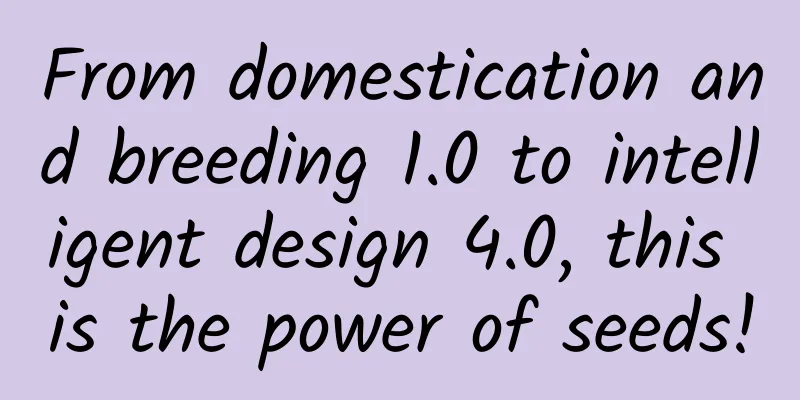From domestication and breeding 1.0 to intelligent design 4.0, this is the power of seeds!

|
Rice provides staple food for about 50% of the world's population. A tiny seed can often change the world. At the recent Tencent Science WE Conference held in Beijing, the dynamics of rice intelligent design breeding 4.0 were presented, which made us feel the history of rice breeding and the power of its seeds. Domestication and breeding 1.0 The domestication of crops by humans is an important symbol of the beginning of agricultural civilization. Through the long period of domestication of wild plants, their shapes that meet human needs have been retained. After domestication, the yield of crops has been significantly improved, and the applicable planting range has also been significantly broadened. The rice we cultivate today can be traced back to the "diploid wild rice" about 7,000 to 10,000 years ago. Source: Tuchong Creative Diploid refers to an individual organism that develops from a fertilized egg and has two sets of chromosomes in its somatic cells. Plants that are cultivated from diploid somatic cells and plants that are doubled from haploids that only have one set of chromosomes are also called diploids. It can be represented by 2n. Humans, almost all higher animals, and more than half of higher plants are diploid. Polyploidy refers to the phenomenon that the chromosome set in the cell nucleus doubles and is passed on to offspring in a heritable way. Polyploidy provides the original genetic material for biological evolution and is considered an accelerator of evolution. Polyploidization is one of the most important evolutionary events in plants. The process of evolution from diploid to polyploid introduces new genetic information. Hybrid breeding 2.0 Hybrid breeding is the process of hybridizing parents with different traits to achieve the recombination of traits: the hybrid offspring may have a combination of the excellent traits of both parents (even superior traits to those of the parents); there may also be a combination of the inferior traits of the parents, or inferior traits that neither parent has. Then, individuals that meet the breeding goals are selected from the many hybrid offspring and further cultivated into new varieties with excellent traits that can be stably inherited. Source: Tuchong Creative The first successful rice hybrid breeding was carried out by American Henry Beache in Indonesia in 1963, for which he won the World Food Prize in 1996. However, due to some defects in Henry Beache's ideas and plans, it could not be promoted on a large scale. Later, the Japanese proposed the three-line breeding method to cultivate hybrid rice, and proposed to find suitable wild male sterile plants as the basis for breeding hybrid rice. Although the Japanese found wild male sterile plants after years of hard work, the effect was not very good; in addition, the Japanese also proposed a series of new rice breeding methods, such as flour driving, but in the end, due to various reasons, they were unable to complete the industrialization of hybrid rice. In February 1971, Chinese scientist Yuan Longping was transferred to the Hunan Academy of Agricultural Sciences to specialize in hybrid rice research. In 1973, the scientific research team headed by him completed the three-line matching and successfully cultivated hybrid rice, achieving a historic breakthrough in hybrid rice. In June 1984, a national hybrid rice research institution, the Hunan Hybrid Rice Research Center, was established, and later the National Hybrid Rice Engineering Technology Research Center was established, both of which have been headed by Yuan Longping. In 1986, he proposed the development view of "utilizing the hybrid advantages between subspecies in the two-line method". After 6 years of hard work, he and researchers successfully broke through the key technology of two-line hybrid rice and promoted its application, achieving good yield-increasing effects. In 1997, he proposed the technical route of "hybrid rice super-high-yield breeding", which attracted great attention internationally. Under his leadership, the first, second and third phase targets of super rice yields of 700 kg, 800 kg and 900 kg per mu were achieved in 2000, 2004 and 2011 respectively. The fourth phase target of 1,000 kg per mu was also achieved in October 2014, laying the foundation for further large-scale and substantial increases in rice production. Molecular Breeding 3.0 Hybrid breeding has its own "disadvantages": the hybridization of the "two sides" of the rice varieties must respect the "choice" of nature. To put it more simply, what kind of "child" will be produced by the combination of two rice varieties is decided by nature, and scientific researchers have no "decision power". What scientific researchers can do is to pick out one that meets the needs and has stable traits from the "children" born, and then mass produce it. This selection often takes ten or even dozens of years of hard work. This is actually "trait selection". With the development of the times and technological progress, researchers have proposed the idea of "letting genes directly select", which is rice molecular breeding 3.0. What does it mean? That is, researchers no longer need to spend a long time to decide what the "child" after hybridization - the new variety of rice will look like. In other words, the molecular breeding of rice is like designing industrial products in industrial production to "design" rice. Source: Tuchong Creative How does rice molecular breeding work? There is a rice gene library - the rice gene database, which stores various rice genes. Researchers use molecular markers to identify "good genes" and "bad genes" for these different genes. Using this method, "personalized" design of rice varieties can be carried out, which can efficiently and effectively cultivate new varieties. Intelligent Design Breeding 4.0 As for the intelligent rice breeding design 4.0 that is turning from theory into reality, Qian Qian, an academician of the Chinese Academy of Sciences and director of the National Crop Germplasm Bank, said that this method may be similar to an artificial intelligence assistant. For example, when we want to cultivate rice varieties that can adapt to different climate changes and have the characteristics of high quality, high yield, stress resistance, and high efficiency, the system can assist in providing or evaluating relevant technical solutions. The key to intelligent rice breeding is to accelerate the digitization of germplasm resources. At the Tencent WE Conference, the "Digital Germplasm Bank" of Tencent Science and Technology Museum was launched, which will become a major boost to fully and efficiently explore and utilize germplasm resources with digital technology. The "Digital Germplasm Bank" uses 3D modeling and other technologies to digitize various crops, enabling them to be presented in three-dimensional dynamics. Source: Tuchong Creative The "Digital Germplasm Bank" allows us to use relevant technologies to explore and achieve accurate collection of crop phenotypic traits, which can help us study the laws of their growth and development so as to "customize" and design better crop varieties. Comprehensive sources: Science and Technology Daily, Voice of Science and Technology Association, Shanghai Academy of Agricultural Sciences, CCTV Agriculture and Rural Affairs |
>>: ChatGPT is almost one year old! How did it develop such fluent conversation skills?
Recommend
Do you have any of these scalp problems? Be careful, they may be causing the problem!
Audit expert: Peng Guoqiu Deputy Chief Physician,...
93% of marketers are troubled by product copywriting. These two tricks can help you solve it easily.
Even a bad product can be popular with good copyw...
Before a major epidemic, how should companies select topics for their new media operations?
The moment the hot topic came, it seemed that eve...
Google, BlackBerry team up to make Android devices more secure
BlackBerry has announced a partnership with Googl...
The EU requires all mobile phones to have a unified charging port. What does this mean for Apple?
Despite Apple's obstruction, the European Par...
What is URL Canonicalization? What does URL normalization mean?
Nowadays, the Internet is becoming more and more ...
4 details determine whether private domain can make money
This article uses the private domain path formula...
WeChat Pay Family Card function upgrade: Added "Other relatives" option with a maximum limit of 3,000
Recently, Tencent Customer Service's official...
Promotional marketing: These 4 creative advertising techniques can increase click-through rate by more than 30%!
Anyone who does marketing promotion may encounter...
How should marketing be done in 2016? Here are 19 trend judgments!
Outstanding wallpapers at http://www.gelono.com H...
From IP to CP: New Brand Operation Methodology
With the rise of Taobao platforms, a large number...
The first batch of young people studying in the United States came out of the small county
Many of the earliest Chinese students studying ab...
The Yanjiao explosion accident sounded the alarm: knowing burn first aid knowledge in advance can "save lives"
On March 13, an explosion occurred in a shop in a...
How to acquire customers online? 5 key core touch points!
If I don’t tell you, 80% of people would probably...
I didn’t spend a penny on promotion and achieved 23 million app downloads!
The author of this article spent 6 hours to creat...









